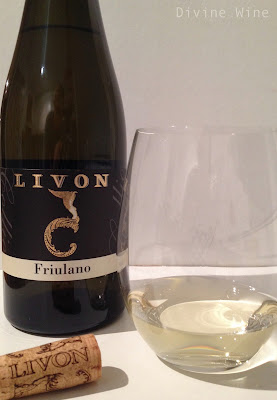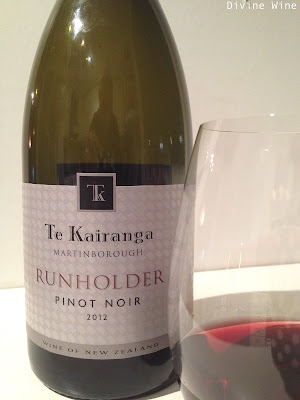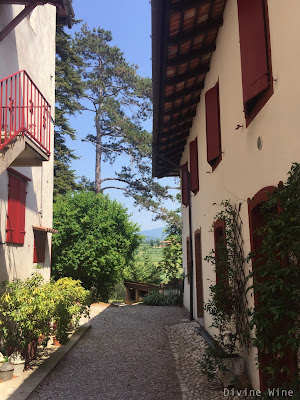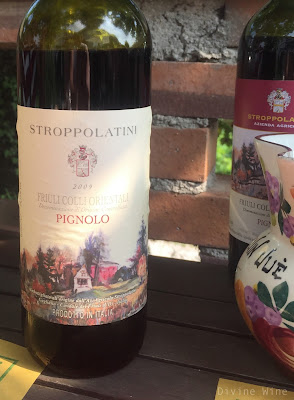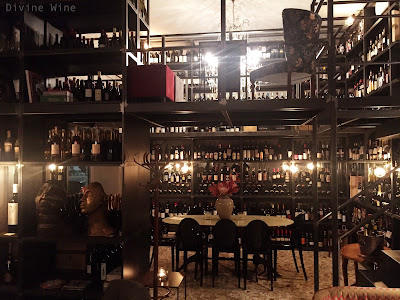 |
| The main building of Stroppolatini winery. |
All this
beauty! The main building, magnificently glowing in every shade of pink
imaginable, and Mrs Barbara Stroppolatini’s fiery red roses as well as the
emerald vineyards are equally competing for my admiration, until Tom, the
(nearly) one-toothed cat, arrives. Not really interested in me, he is just
checking whether San Daniele ham is already being served to the guests? Sorry Tom, not yet, priorities first (although, I suppose, ham really is Tom’s
priority). It is time to talk about wine.
And there
comes Federico Stroppolatini, our brilliant host, who is together with his
father and boss, Il Capo, Giuliano
Stroppolatini, responsible for the entire process of viticulture and winemaking
at Stroppolatini winery. As Federico narrates the history of the farm,
everything around us becomes alive. In the 18th century there were only
observation posts on this hill, up until the 1820’s, when a relative of
Stroppolatini, Luigi Francesco Spezzotti, bought the place. 170 years ago the
first vineyards were planted making this farm one of the oldest in the
area. Simultaneously, the tradition of
excellent hospitality was established only to be continued today at
Stroppolatini’s attractive B&B Casali del Picchio. As a part of our tour, we
got to take a peek at its beautiful, classic Riviera style decorated rooms that,
I have to say, are a dream accommodation for a wine lover travelling in Friuli.
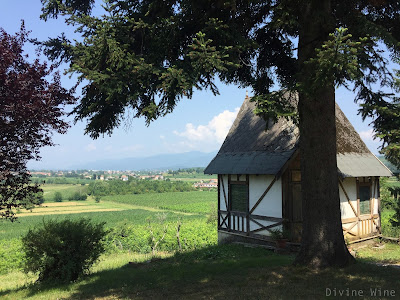 |
| 170 years old vines in front of violinist's house are featured in 1850's art work. |
So
impressive was the hospitality here also in 1850’s that a well known artist, Giuseppe Liusso,
after an extended stay, painted a picture of the scenery as a thank you gift
for his hosts. Astonishingly, what we see on the painting is practically identical
to the scenery we witness today: the very same pink main building, the small
white violinist’s house (built to spare others’ ears from the family’s violinist
practising) and, most precious of all, the actual Friulano and Merlot vines
that still grow in the hillside vineyard in front of the violinist’s house,
still as healthy and productive as ever. 170 years old, these vines are as old
as the winemaking tradition of this house. Treasuring the tradition and beauty
of their farm, Stroppolatinis have printed the painting on their label.
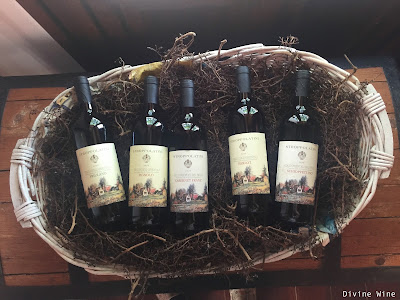 |
| The historical scenery of the farm is printed on Stroppolatini label. |
Il Capo, Giuliano, and his viticulture and oenology
studying university student son, Federico, continuously explore how to best
combine today’s knowledge with the local, artisanal winemaking tradition.
Aiming at high quality first and foremost, Giuliano Stroppolatini decided in 1999
that the farm’s wine production should be expanded and made a public activity
on the contrary to making wine solely for family consumption. More vineyard
area from a neighbour was purchased and local varieties planted, amongst them
Pignolo - even if Giuliano Stroppolatini’s close friend, also a producer, first reacted along
the lines of: ”Oh, no, no Pignolo, that grape juice can only be used for
writing, as ink!”.
Nevertheless,
Giuliano was to stick to his guns, and today Federico thanks his father for his
bold choices. Now Pignolo is Stroppolatini’s capolavoro, or as Federico puts it: ”This wine is our firework”.
Stroppolatini’s Pignolo is one of the few 100% Pignolo varietal wines produced
in this area where the grape is autochthonous, which makes it one of the few
100% Pignolo wines in the entire world. Regardless of its unpredictable and low
yields, its utter messiness in the winery (in this sense Giuliano's friend was indeed
right) and the prolonged aging it demands, Federico maintains that Pignolo
produces results that make it all worthwhile. Tasting the resulting wines will
be the topic of my winery visit part II blog post, when Federico takes us to
the cellar. But we will get there, to taste Pignolo, I promise! For this part I
post, my focus is on Stroppolatini’s winemaking philosophy, to highlight the
background of their products and thus enable the full appreciation of the
tasting experience ahead.
 |
| The wonderfully inviting Stroppolatini family (from left): Barbara, Giuliano, Marianna, and our brilliant host, Federico. (Image: stroppolatini.it) | |
|
|
Stroppolatini’s
viticulture and winemaking practices are focused around sustainability and
uninterventionist philosophy. Driven by the objective of producing varietally
expressive, local tradition reflecting, and Colli Orientali area’s uniquely
mineral ponca -terroir communicating
wine, everything that could disturb the vine’s own voice is avoided.
Stroppolatinis choose not to use pesticides or fertilisers (apart from humus
from composting plants), and minimize machinery usage in the vineyard,
harvesting manually. For disease prevention, only following the plants’ health
with a keen eye and, when necessary, traditional sulphur and copper oxide based
sprays are used. Systemic interventions are avoided to the greatest extent
possible, and used only if they are imperative. Fortunately, the last such occasion
took place over five years ago, and since then systemic interventions have not
been used. The oldest, 170 years old vines don’t need much help staying healthy
as they have built a strong immunity surviving throughout the centuries. This
is exactly the direction towards which Federico would like to see all of their
vines developing through sustainable disease prevention.
 |
| I was in awe of Mrs Barbara's roses. |
When it is harvest time, Stroppolatinis invite the locals to work with them, manually
picking only the healthy grapes, being careful not to damage them. Federico
wouldn’t want to use machinery for the harvest even if he could, because
”machine harvesting takes the magic out of the wine”. He enjoys the feeling of
community that the shared experience of harvest brings to their vineyards.
Besides, the most important human skill, the careful selection of only the ripe
and intact grapes, and their gentle picking, can’t be taught to a machine. For
a small, artisanal winery of six hectares, the guarantee of quality is the
precision of human touch.
 |
| Colli Orientali's mineral ponca soil consists of eocene marl. |
Moreover, in
the winery, the current knowledge is combined with traditional,
uninterventionistic winemaking as a modern, pneumatic press only gently breaks
the skins of the grapes before fermentation, releasing just right proportion of
colour an tannins for the traditional, long macerations. Natural fermentations
of the yeasts on the grape skins are allowed, boosted only by using locally
isolated, hence terroir reflecting, yeast strains. The fermentations take place
in stainless steel, and the natural yeasts would struggle without the addition
of selected yeast strains. Further, the resulting aromas of wine are better controlled
using selected yeasts that will dominate the fermentation, while the complexity
of the aromas is preserved by allowing the presence of natural strains in the
mix.
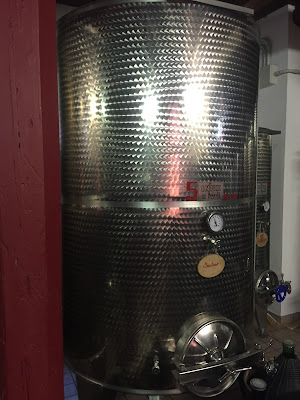 |
| Friulano matures 18-20 months in stainless steel. |
After
exceptionally long macerations and maturations of minimum of 18 months for
white wines and 2 years for red, there are plenty of stabilizing agents in the
wines, and, simultaneously, the deposits have had plenty of time to settle.
Hence, Stroppolatinis don’t use fining agents at all, and need only to use
minimal levels of SO2 (sulphites) to ensure the preservation of their wines. All
of the above taken together, Stroppolatini’s production is practically organic,
although they have not gone through the certification process. However, it is
safe to say that they take pride in sustainable and carefully preventive
vineyard practises as well as uninterventionistic winemaking.
In Friuli,
the long maceration and maturation times for whites are traditional, but today
more an exception than a rule. Most whites are quickly pressed off their skins
and bottled to be sold the year following their vintage, producing a light,
crispy, fruit-driven style. However, Giuliano Stroppolatini does not follow the
whims of fashion but believes in structured whites he produces from the local
Friulano grape. Keeping the juice in skin contact for ten days extracts colour,
flavour and even tannin to the white wine. Moreover, he has recently started to
experiment further into traditional wine making, bringing in oak. Now two
versions of long matured Friulano are being made at Stroppolatini: the fruity,
yet structured, 18-20 months stainless steel matured version, and the creamy,
full-bodied oak matured version, that has undertaken malolactic fermentation.
All the oak barrels used, also for red wines, are used, neutral tonneaux made
of French or Slavonian oak. The result of oak aging is gentle, controlled
effect of oxygen without noticeable oak flavour influence. Reaching this
sentence, dear readers, makes me realise that I’m heading straight to the wine
cellar. So, it is time to restrain my fingers running on the keyboard and start
wrapping up.
 |
| Highly productive Friulano vines getting better with age! |
Upcoming on
the II part of Stroppolatini winery visit: a legion of tasting notes from the
Stroppolatini wine cellar featuring their excellent varietal wines of both
international and interesting and fantastic local, Friulian grape varieties
such as Pignolo. Plenty of laughter and fun with our excellent host Federico,
one of our entertaining themes being Beetle, who indeed likes prosciutto. Or as
Federico says: ”The cat arrives, when the ham arrives.” But why does Tom
have (almost) only one tooth left? Also that will be revealed in the part II.
Until then, dear readers!
Coordinates
Azienda Agricola Stroppolatini
Strada di Prepotto, 21
Gagliano
33043 Cividale del Friuli, Italia
stroppolatiniazagri@hotmail.it
casalidelpicchio@virgilio.it
 |
| Staying at B&B Casali del Picchio is a wine lover's dream. |
